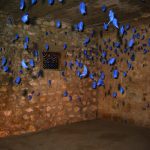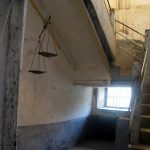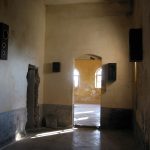- Bird Calling
- Crossing Point
- Balancing Act
- Birdhouse
Sinop Penitentiary, Sinop, Turkey, 2006
Director: Melih Görgün
Bird Calling Turkish blue bird feathers, light, sound
Located in an old penitentiary built originally as the city’s fortress in 2000 B.C. adjacent to the Black Sea, and used as a shipyard during the Roman, Byzantine, Seljuk, and Ottoman periods, this project was part of “Sinopale,” the first Biennial in the city of Sinop Turkey, which commissioned artists to select sites and work in response to the social history and context of the city. This installation took place in the children’s section of the Sinop Penitentiary, and consisted of light, shadows, and the sounds of bird songs. A few hundred blue feathers hung from the ceiling and were lit by spotlights, projecting shadows of the feathers on the stonewall. As viewers walked between the hanging feathers, the shadows cast by their own bodies overlapped the feathers that moved in the air. The only light that came into the harsh stone room was through the punched holes of a rusted steel plate that covered the three windows. Songs of the local Turkish birds enveloped the space, evoking the desire to be free from confinement.
Crossing Point table, feather, salt, sound
An old table found in the penitentiary was placed in the center of a dark room. Salt from the Black Sea covered the surface of the table, and a large feather hung from the ceiling. The movement of the people wandering through the room caused the feather to move slowly across the salt like a quill pen, erasing the names of the young prisoners written on the salt, while the low murmur of the local Turkish birds filled the room.
Balancing Act old scale, fig, salt
As visitors exited the room to ascend the staircase, they noticed an old scale hung from the ceiling. One plate contained a small mound of salt from the Black Sea, and the other contained figs, which were picked from a tree located on the prison grounds. The fig is one of the oldest fruits (more than 11,000 years old), and has been regarded as sacred by many cultures. The ancient Hebrews looked upon the fig tree as a symbol of peace and plenty. Buddha attained his Awakening under the fig tree. Mohammed’s followers called it the Tree of Heaven. The many seeds in the fig are supposed to signify unity and the universality of true understanding, knowledge and faith. Salt symbolizes life, (as in the expression “salt of the earth”), as well as sorrow and pain. The fig and the salt are weighed against one another, as they are juxtaposed on the scale.
Birdhouse empty speaker cabinets, sound
Upon ascending the staircase and passing through the hallway, the bird songs emerged again from the far end of the large rooms. The woofers and tweeters were removed from the speaker cabinets, leaving them to look like birdhouses. Eight speaker cabinets were installed in the hallway, leading visitors to two of the largest rooms in the children’s prison. Tarpapers covered all the windows of one room, which made this space pitch dark, and the other was left with windows open which allowed the people to overlook the outer wall of the prison to the Black Sea beyond. A total of seven empty speaker cabinets were installed in the large room, filling the bright space with the sound of the bird songs. Birds cannot enter, nor can the children escape the room.
Out of the Blue LED, birdcage, metal, ladder, sound
From the bright hallway, viewers entered the darkened large room on the second floor of the children’s prison, and noticed a tall ladder positioned against the wall. The entire windows of this room were covered with thick tar papers. An old birdcage hung from the ceiling, containing a tiny silhouette of a bird in flight, which was cut out of a reflective sheet of metal. The movement of people walking inside the pitch-dark room swayed the birdcage in a very slow motion, which made the bird silhouette to shimmer in the dark. A cobalt blue LED (light-emitting diodes) was installed inside the birdcage, which was programmed to pulse slowly, resembling a human heartbeat. A slight movement of the cage made a silhouette of a bird to appear and disappear as a large shadow on the concrete wall as the light emitted a dark blue color. Furthermore, the light pulsation made a small birdcage cast a large shadow, filling the wall and the ceiling with a shadow of a birdcage, creating a haunting image of confinement, while the sounds of local Turkish birds filled the space.
Counting with the Moon digital print, television monitor, film
In the waiting room of the medical facility of the prison, an image of Nagasawa’s hands holding a moon was printed on vinyl and hung in front of the window, casting the shadow of the window’s bars from behind, similar to a large light box. Opposite of the digital print image was an old television monitor, representing an image of a moon held between Nagasawa’s lips. The moon rotated twenty-eight times in a loop, suggesting the phases of the moon. Since the Islamic calendar is based on the lunar calendar, this piece was about time and the endless counting prisoners must endure as they wait in the prison, especially in a medical facility, where this piece was installed.




